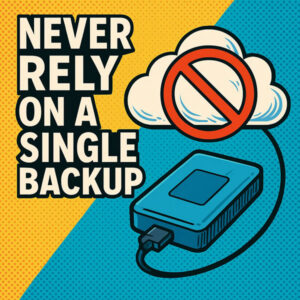 When it comes to protecting your digital assets, backups are not optional—they’re essential. Yet one of the most common and dangerous misconceptions in data management is that a single backup is enough. Whether you’re safeguarding personal photos, business-critical databases, or the contents of an entire website, relying on only one backup—regardless of where it’s stored—puts you at serious risk. In today’s world of ransomware, accidental deletions, hardware failures, and cloud outages, the golden rule is simple: Never rely on a single backup.
When it comes to protecting your digital assets, backups are not optional—they’re essential. Yet one of the most common and dangerous misconceptions in data management is that a single backup is enough. Whether you’re safeguarding personal photos, business-critical databases, or the contents of an entire website, relying on only one backup—regardless of where it’s stored—puts you at serious risk. In today’s world of ransomware, accidental deletions, hardware failures, and cloud outages, the golden rule is simple: Never rely on a single backup.
Why One Backup Isn’t Enough
Let’s say you’ve backed up your website to an external hard drive. That’s a great start—but what if that drive fails? What if it gets stolen or damaged in a fire or flood? Alternatively, maybe you’re backing everything up to the cloud. What happens if your account is compromised, your cloud provider experiences downtime, or you accidentally delete the backup itself? Any single point of failure can turn a well-meaning backup into a useless effort when you need it most.
This is why professionals in IT and data security recommend the 3-2-1 backup strategy:
- 3 total copies of your data
- 2 different media types (e.g., external drive and cloud)
- 1 copy stored offsite
This approach dramatically reduces the risk of total data loss, even in worst-case scenarios.
Types of Backups
To build a reliable backup strategy, it’s important to understand the common backup types:
- Full Backup: A complete copy of all files and data. It’s the most comprehensive, but takes up the most space and time to create.
- Incremental Backup: Captures only the changes made since the last backup of any kind. This saves space and time but requires the full backup and each incremental backup to restore.
- Differential Backup: Backs up changes since the last full backup. It’s faster to restore than incremental backups but takes up more space over time.
Using a combination of these strategies can help you maintain quick recovery times while also preserving storage space.
Local vs. Cloud Backups
Local backups—such as those stored on an external hard drive, NAS (network-attached storage), or USB stick—offer fast recovery times and complete control over your data. However, they are vulnerable to theft, physical damage, or hardware failure.
Cloud backups, on the other hand, offer offsite protection and can often be automated. They’re ideal in disaster recovery scenarios like natural disasters or equipment theft. But cloud services have their risks too: outages, cost over time, security concerns, and dependency on internet access.
The best approach is to use both. A local backup provides fast access, while a cloud backup gives you resilience. That way, even if one fails, the other is available.
Backup Best Practices
- Automate your backups. Human error is the #1 reason backups fail. Use automated tools or scheduling scripts to ensure consistency.
- Test your backups regularly. Don’t wait until a crisis to find out your backups are corrupt or incomplete. Periodically perform test restores.
- Use versioning. Backups that keep older versions of files let you recover from accidental edits or deletions.
- Encrypt sensitive data. Especially if you’re storing backups in the cloud or offsite, encryption helps protect your data from unauthorized access.
- Monitor and log backup activity. Be aware of what’s being backed up, when, and whether any errors occurred.
- Separate backups from production systems. Keep backups isolated from the systems they’re backing up. Ransomware often targets attached drives.
- Document your backup and recovery procedures. Especially for businesses, having a clear plan helps speed up recovery and minimize downtime.
Common Pitfalls to Avoid
- Thinking sync is the same as a backup. Services like Dropbox or Google Drive are great for file access, but they sync changes—including deletions and overwrites. A true backup preserves previous states.
- Not backing up frequently enough. Your backup frequency should reflect how much data you can afford to lose. If your work changes hourly, a weekly backup is not enough.
- Storing backups in the same physical location. If your office or home is hit by disaster, all local copies may be lost.
Final Thoughts
The peace of mind that comes with a strong backup strategy cannot be overstated. Whether you’re a freelancer, a business owner, or a hobbyist, data loss can be devastating—but it’s also preventable. The key is to adopt a layered, redundant approach that eliminates single points of failure.
So the next time you back up your data, remember: one backup isn’t a plan—it’s a liability. Build your backup strategy like your business depends on it, because one day, it just might.
